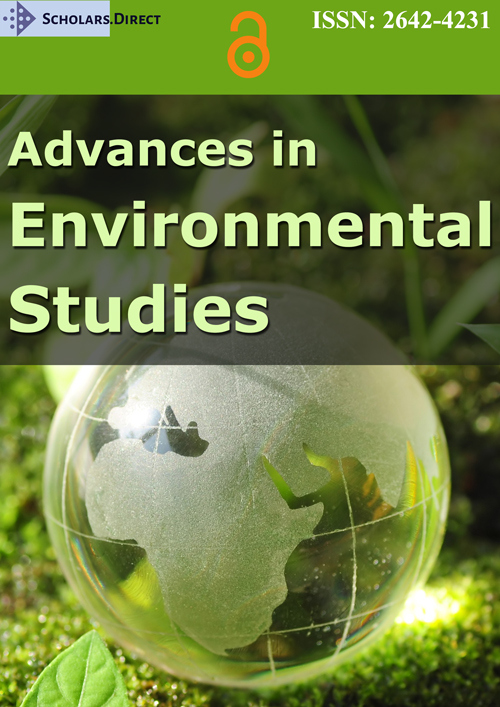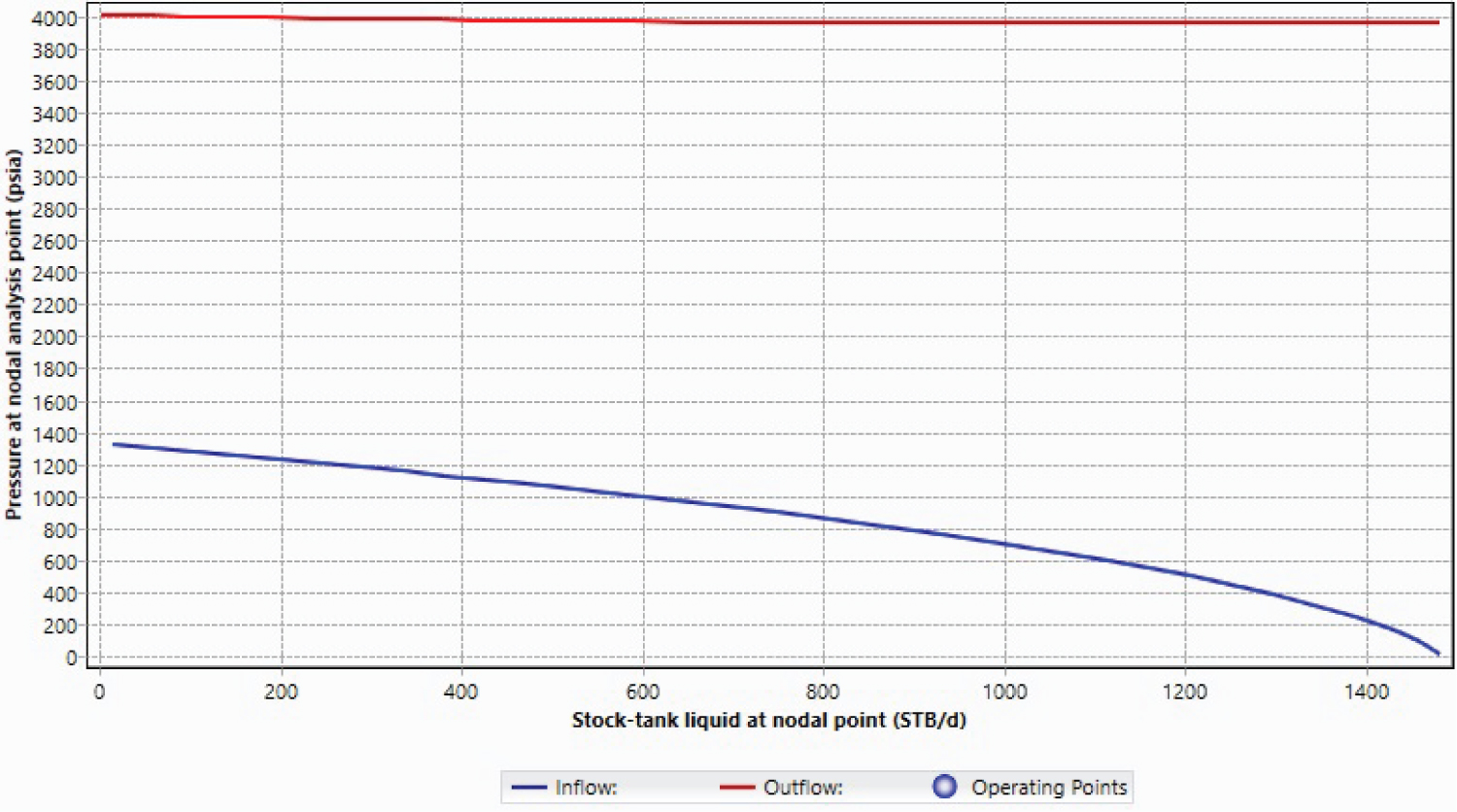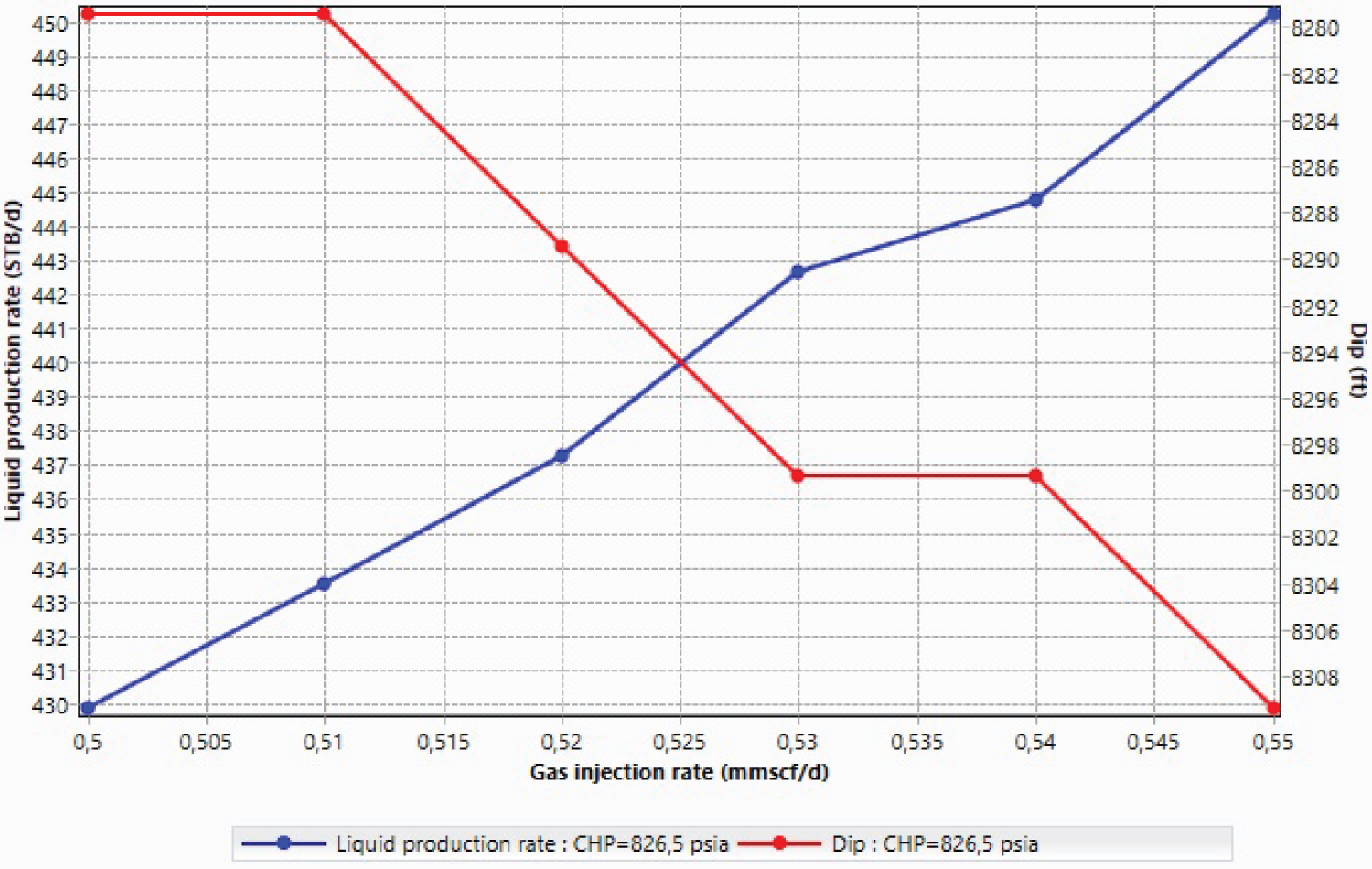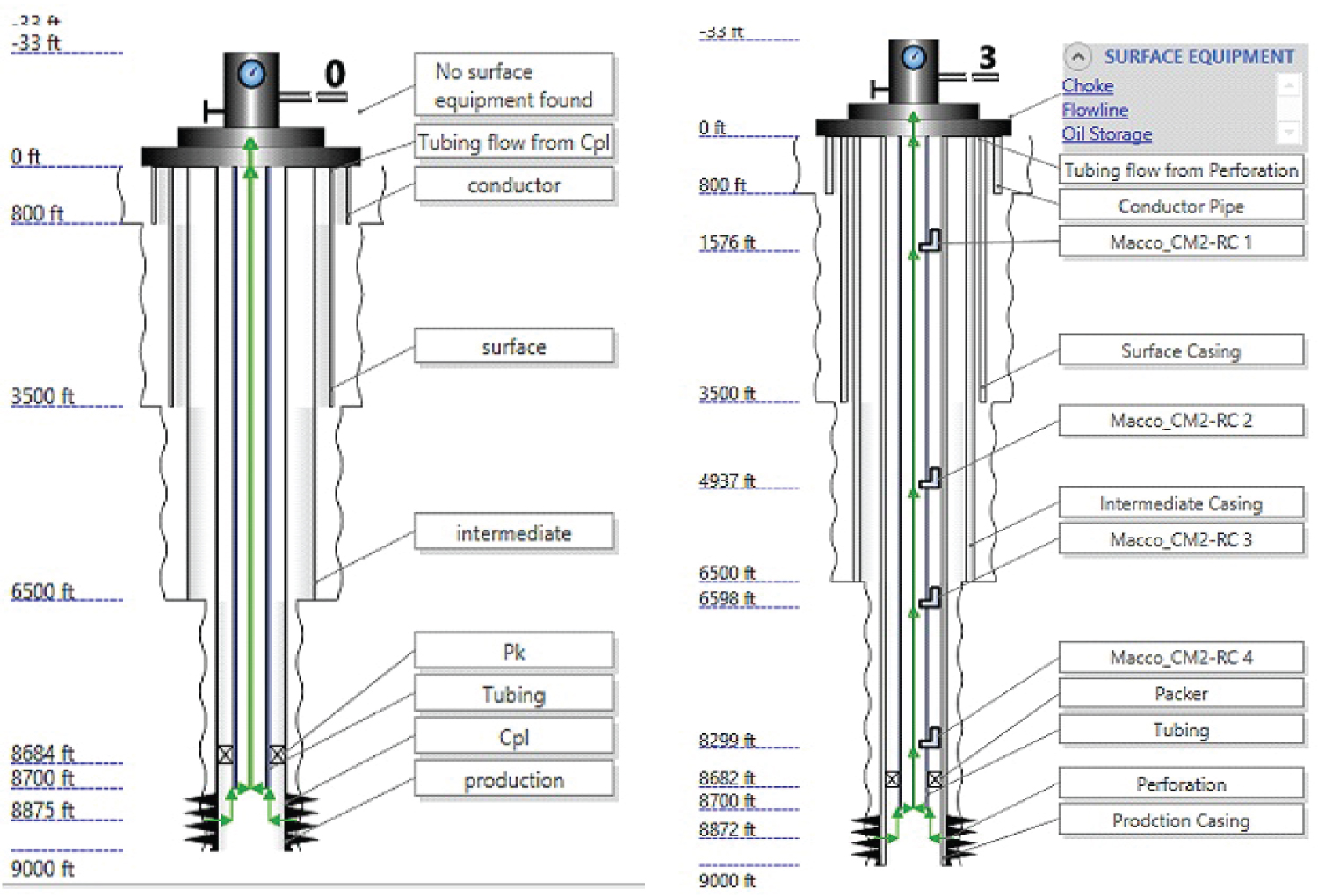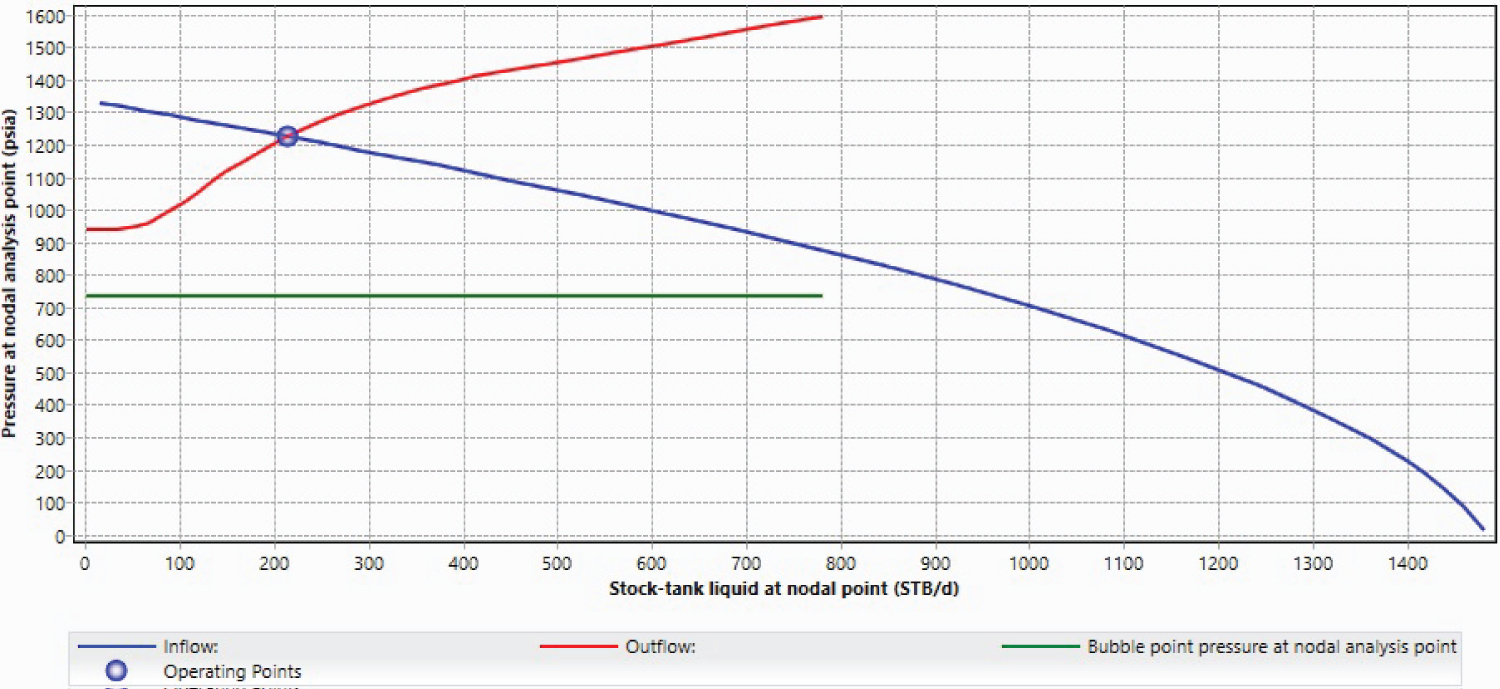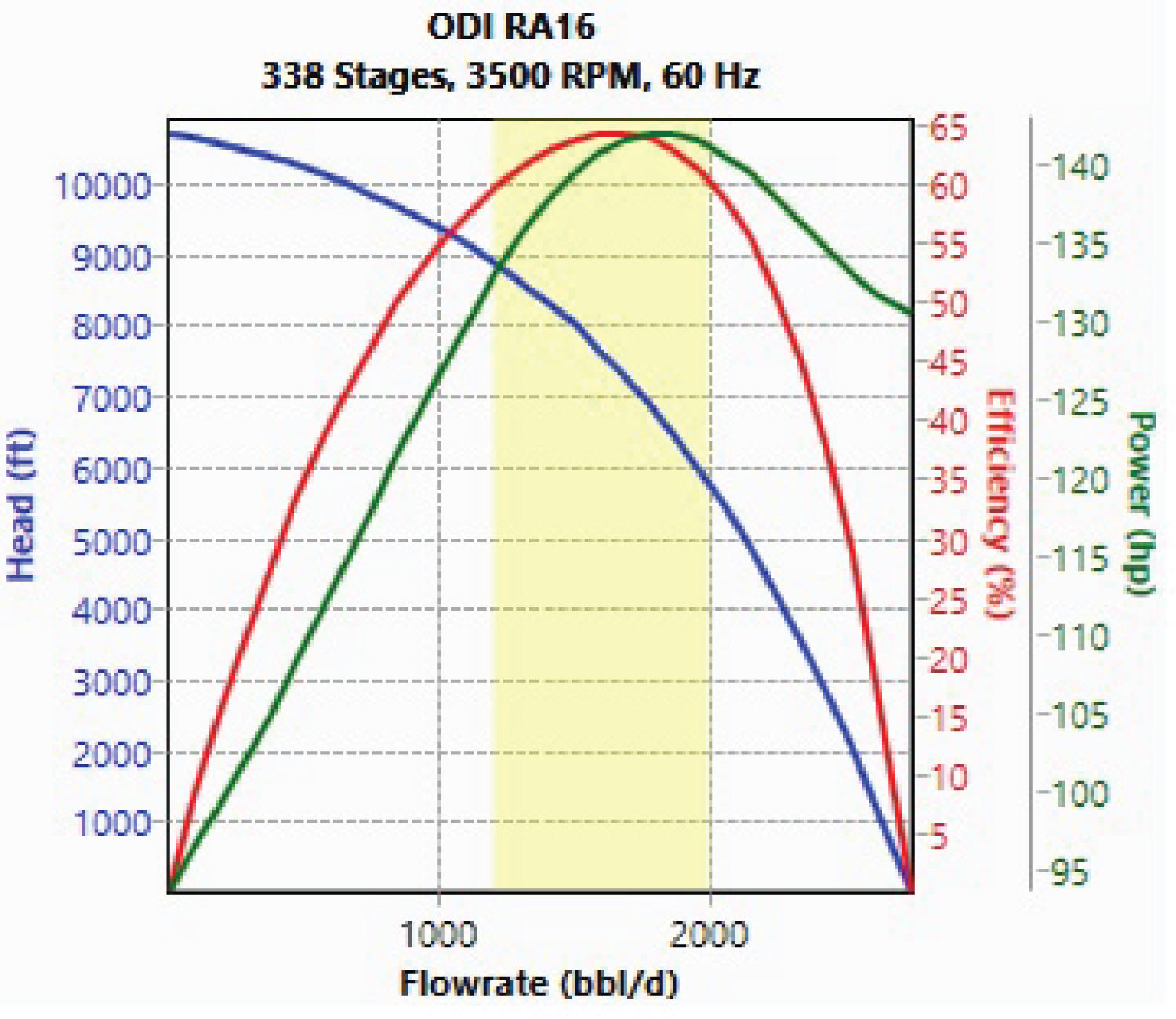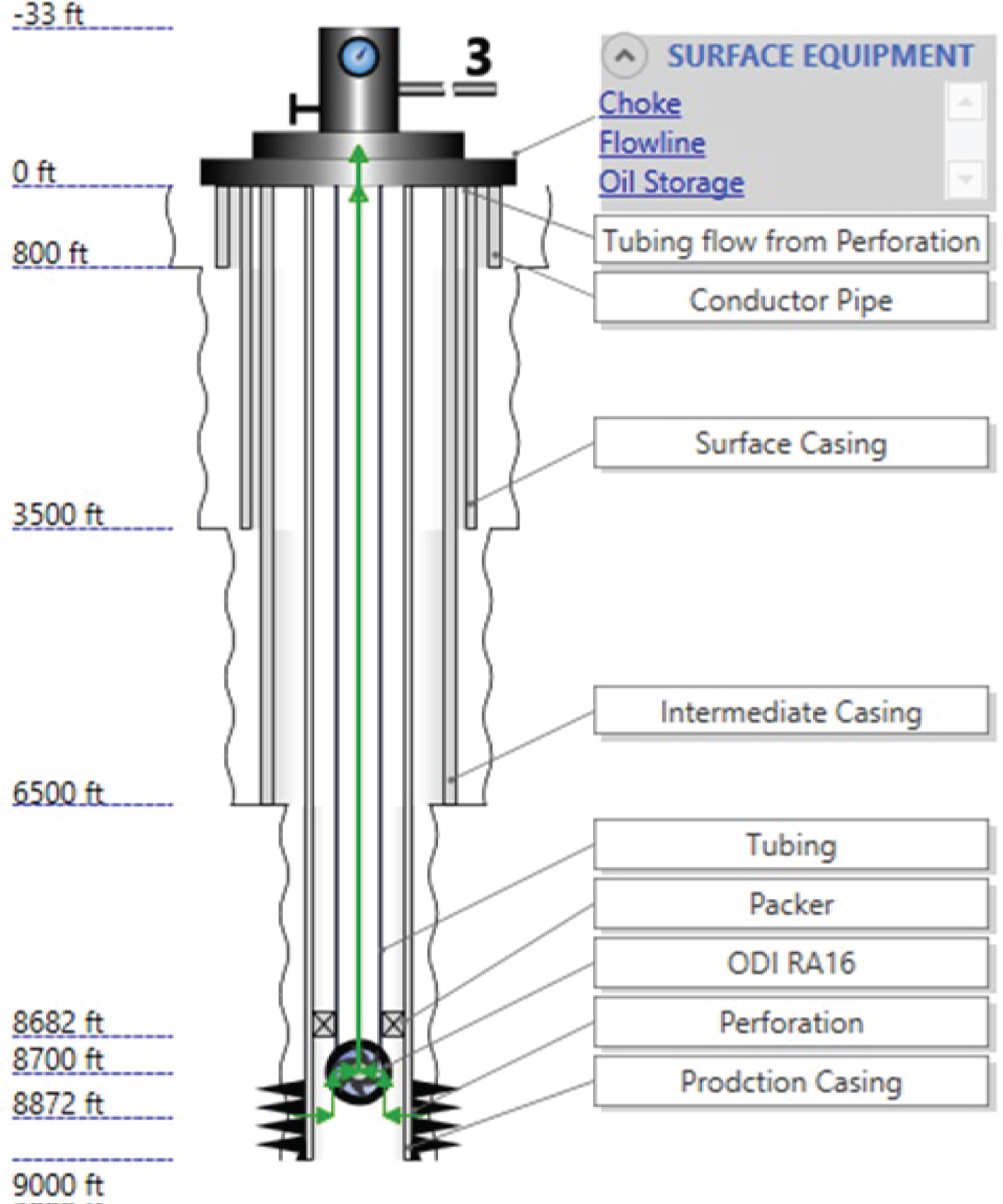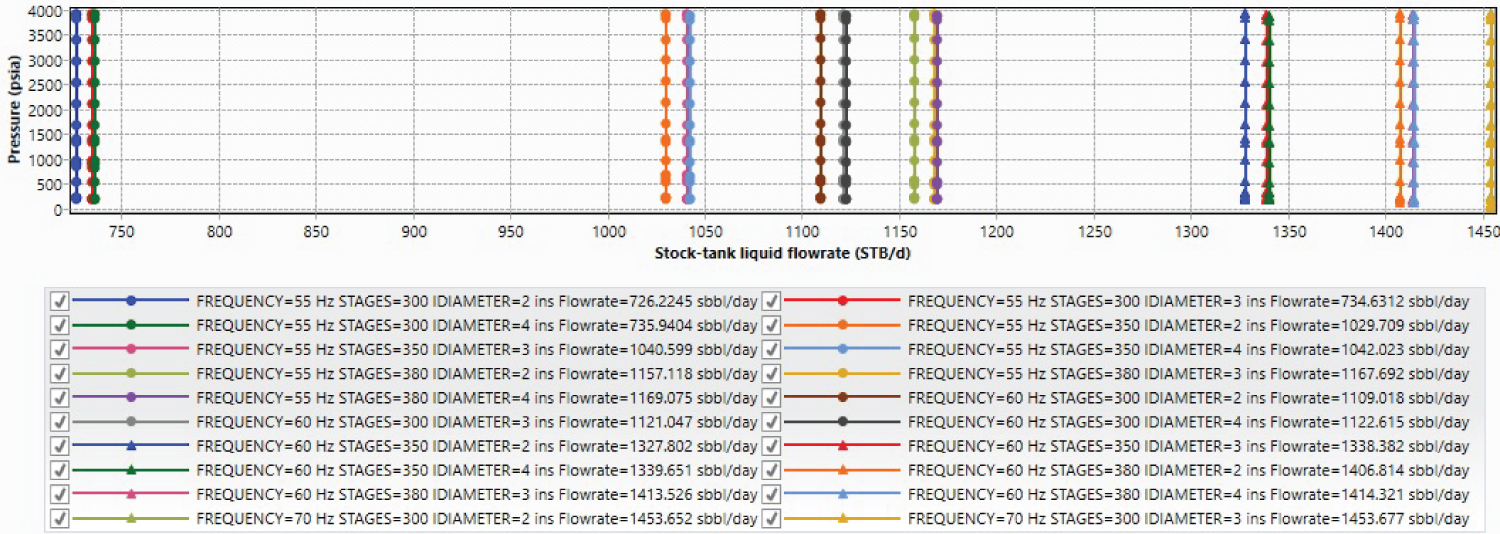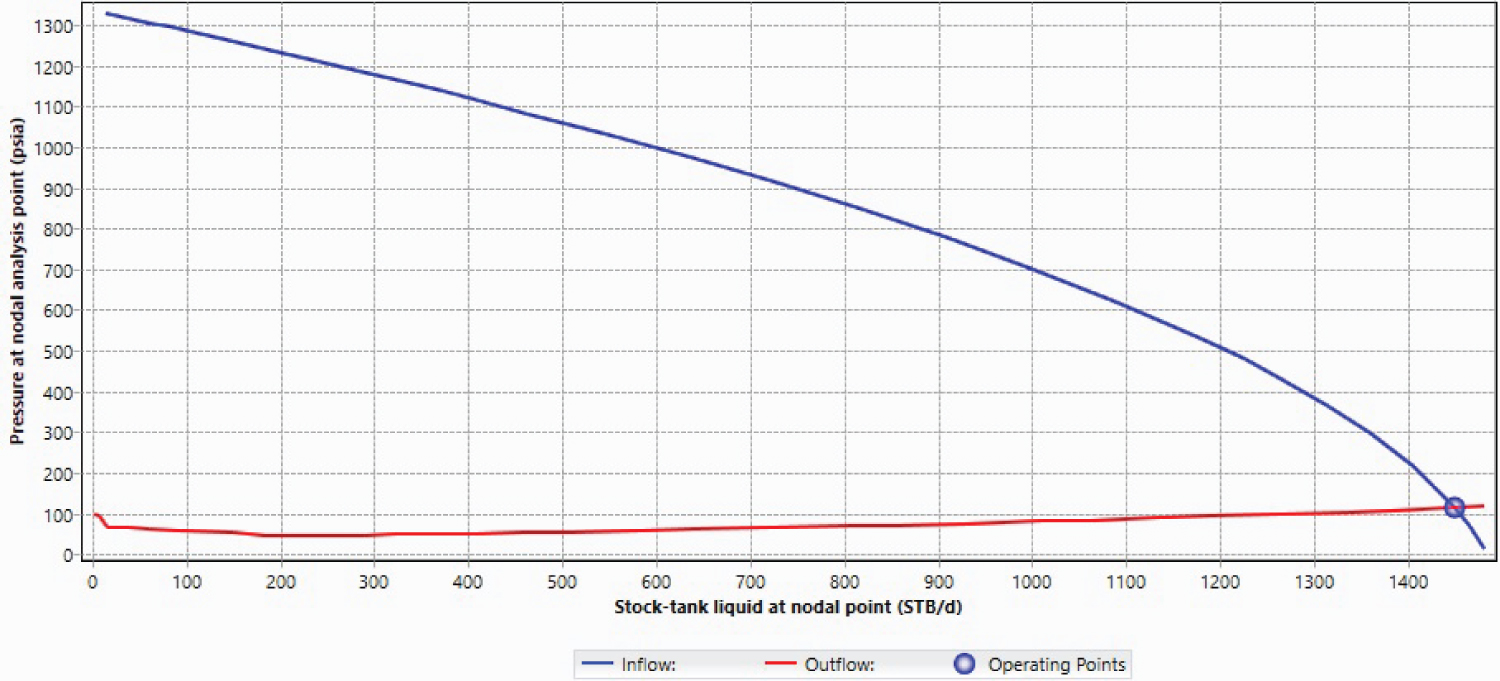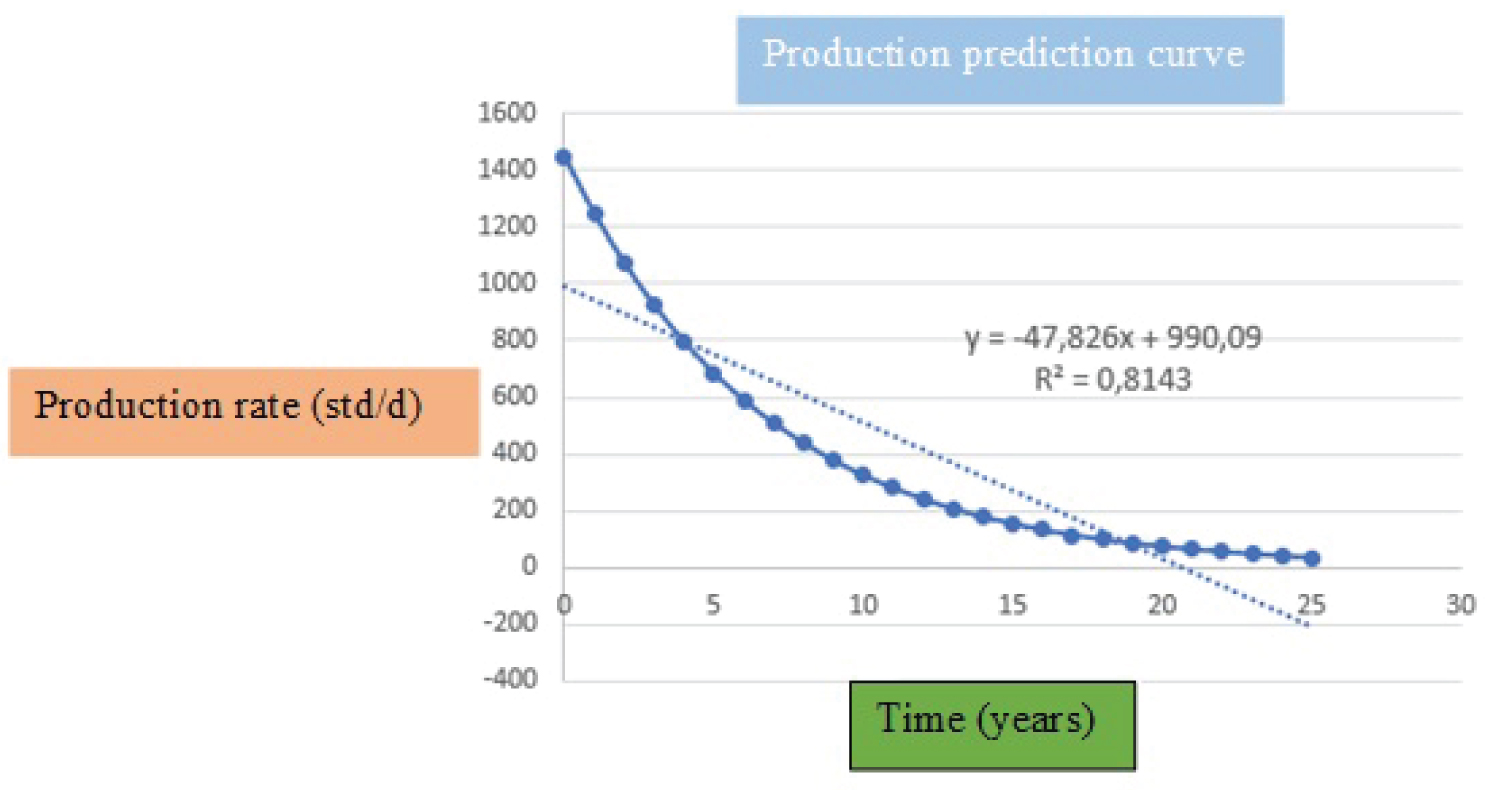Boosting Well Oil Production by Converting Gas Lift Activation to an Electric Submersible Pump
Abstract
The production in the basin named "X" (for confidential reasons) through the well called "Z" (for confidential reasons) located in the eastern part of the basin X decreases as time goes despite its activation by gas lift. The goal of the paper is to activate the well Z by converting its activation by gas lift to an electric submersible pump (ESP) in order to maximize its production. From the completion and PVT data processed in PIPESIM and integrating a number of calculations by nodal analysis and decline curve methods, the results obtained show that the well Z without activation does not produce. The activation of well Z by gas lift reveals that the optimal flow rate is 213 STB/d and is very low therefore economically uneconomic with a profitability of $721,214.663. The replacement of the gas lift activation by the ESP activation allows the well Z to provide an optimal flow rate of 1450 STB/d with a water percentage of 83.3% and a profitability of $6,525,693.13, guaranteeing an operation for thirteen years with a return on investment after eight months. This activation conversion from gas lift to ESP allows for the enhance of production from high percentage of water wells in the same geographical areas and to consider the reactivation of abandoned wells or wells that are assisted by other methods such as gas lift.
Keywords
Gas lift, ESP, Nodal analysis, Pipesim, Profitability, Return on investment
Introduction
As oil is produced, the oil field matures and the reservoir pressure decreases [1-3]. This is due to the fact that the pressure at the bottom of the well becomes greater than the pressure in the reservoir, so the energy in the reservoir is no longer sufficient to bring the hydrocarbons to the surface. This has led to a considerable reduction in the flow rate, which can even lead to production shutdown [4-6]. To overcome this type of problem, activation methods involve reducing the hydrostatic column in the well [7-14]. This activation will cause formation fluids to flow into the well. In other words, the downhole pressure is reduced to allow hydrocarbons to be produced towards the surface. There are several activation methods: The progressive cavity pump [12], the sucker rod pump [13], the submerged electric pump [7,8], the plunger lift, the hydraulic pump and the gas lift [9-11]. ESP activation is one of the feasible and sufficiently efficient methods of raising the productive flow rate of a depleting well without hindrance [15-17]. In the case of well Z, production, which was occurring naturally, began to fall as reservoir pressure decreased. This well was activated by gas lift and provided an optimum flow rate of 213 STB/d with a very low water increase of 83.3%. The aim of this study is to propose a new technique, that of the submerged electric pump, in order to assess its effect on production. In other words, it involves activating the well by converting the gas lift into ESP.
To accomplish this work, it will be necessary to carry out a nodal analysis to assess the production status of the well; carry out a gas-lift design to show its performance on the well in terms of production flow rate; - carry out an ESP pump design to determine certain characteristics such as: The optimum depth, the number of stages and the operational flow rate; improve production through sensitivity analysis; draw up an economic balance sheet to justify the choice of method. To achieve these objectives, this study combines volumetric methods based on empirical formulae, and graphical methods based on the interpretation of charts applied to completion and PVT data for well Z. This paper is structured in two sections, apart from the introduction which represents the first section, the conclusion represents the last section and the bibliographical references: Section 2 presents the data, tools and methodology used. Section 3 presents the various results obtained.
Data, Methods and Results
The main data used are of two types: Completions data and reservoir PVT data. The data used to carry out the well activation are presented in Table 1.
PVT data for the reservoir are presented in Table 2.
The PIPESIM software, Excel software, nodal analysis, decline curve and economic evaluation methods are used to attain the aims of this paper.
Results of the activation of the well Z by using successively gas lift and ESP
The nodal analysis of well Z at its initial state without activation is presented in Figure 1.
Figure 1 shows that the well is not delivering any fluid to the surface because the blue curve (IPR: Inflow Performance Relation), which is the energy that the reservoir can supply, and the red curve (VLP: Vertical Flow Performance), which is the energy supplied by the well, do not intersect. It also shows that the reservoir pressure is lower than the pressure at the bottom of the well.
Activation of the well Z by using gas lift: Figure 2 is used to generate a maximum depth of gas injection into the production tubing and the optimum gas flow rate required to produce an optimum quantity of oil at the surface.
According to Figure 2, the intersection of the blue curve (showing oil recovery) and the red curve (characterizing gas injection pressure) gives the optimum gas injection rate (which is 525 MSC/D) on the x-axis, the oil production rate on the y-axis and the maximum injection depth (which is 8229 ft) on the right. The optimum point for injecting gas into well Z is calculated as a function of well height, well pressure, well temperature and the absolute open flow rate of the well at the time when the pressure at the bottom of the well is greater than the reservoir pressure, as shown in Figure 3.
In Figure 3, the intersection of the pressure curve, casing gas pressure curve and depth curve gives the maximum height at 8299.9 ft and at this depth the first valve is installed. The design of well Z before and after activation of the gas lift is shown in Figure 4.
The design of Well Z prior to gas lift activation is shown in Figure 4a. Figure 4b shows Well Z with four valves in which the first valve is at 8299 ft, the second is at 6598 ft, the third is at 4937 ft and the fourth is at 1576 ft. It is essentially made up of the production tubing, the conductor pipe, the surface casing, the intermediate casing, the production casing and the production packer and their various heights. The gas-lift diagnostic produced Figure 5.
In Figure 5, the intersection of the IPR curve in blue and VFP in red gives the flow rate produced by the well, which is 214 STB/d with a bottomhole pressure of 1224 psia. This means that the gas lift was well installed, as the pressure at the bottom of the well rose from 4,000 psia to 1,224 psia. To overcome this low flow problem, it is necessary to convert this gas lift activation to ESP.
Activation of the well Z by using ESP: The ESP design after simulations gives the characteristics shown in Table 3.
Figure 6 shows the various parameters that help to optimize the ESP.
Figure 7 presents the design of the well Z activated by ESP.
Figure 7 shows that the ESP is installed at a depth of 8700 ft just above the perforation. The nodal analysis of the ESP-activated well Z is shown in Figure 8.
The point at which the IPR and VLP meet gives the well flow rate and the bottomhole pressure of well Z as shown in Figure 8. Table 4 shows the operational flow rate including the operational pressure.
The results in Table 4 show an increase in operating point giving a high fluid flow rate equal to 1316.16 stb/d. There is almost a 3-fold increase in flow compared with gas lift activation. Despite this flow rate provided by the ESP-activated Z-well, it is possible to improve it using sensitivity analysis. Table 5 shows the influence of wellhead pressure on the well Z activated by ESP.
Table 5 shows that for the same tubing diameter and a water level of 83.3%, reducing the wellhead pressure leads to a considerable increase in production flow. From Table 5, the wellhead pressure to be selected is 100 psia. The type of ESP chosen is ODI RA 16 and the reservoir frequency is set at 65 Hz. When the frequency, number of stages and internal diameter of the flowline are significantly increased, the production flow rate increases, as shown in Figure 9.
Increasing the number of stages can put a load on the motor. It is preferable to produce with the same number of stages and modify the internal diameter of the flowline and the pump frequency. The sensitivity curves show the parameters on which the producer can act to make the pump even more efficient without modifying the basic equipment and without destroying the pump. Table 6 shows the optimum values to be taken into consideration to achieve better production in well Z.
Once the optimum parameters have been obtained, they are replaced in well Z and simulated again in PIPESIM. The optimum flow rate obtained is 1450 STB/D with a bottom pressure of 115 psi, as shown in Figure 10.
Economic evaluation
The lifetime of well Z is determined using the exponential model shown in Figure 11.
Figure 11 shows that well Z has an operating life of thirteen years, as the flow rate at year thirteen is 239.68 STB/d greater than the gas lift flow rate (see Table 7).
The profitability of the pump is assessed over the thirteen years of production. The amount of reserves in place in well Z is 5 million barrels. Exploitation of well Z over thirteen years gives a quantity of oil extracted of 3,258,990.97 barrels and the quantity of reserves remaining in place is 1,741,009.027 barrels. The return on investment is 0.80595687 per consequence. The payback period for ESP-activated well Z is eight months. Table 8 shows the Capex and Opex of the gas lift activated well Z.
The cost of oil produced by well Z activated by gas lift in one year is $103,867.32 and the revenue over one year is $1,233,424.43. The taxes paid to the State are $370,027.629. The total expenditure for well Z activated by gas lift over one year, taking into account capex, opex, the cost of oil and tax, is $512,209.763. The cash flow (income - expenditure) for the Z well activated by gas lift over one year is $721,214.663. The capex and opex for the ESP-activated Z well are shown in Table 9.
The cost of oil produced by well Z activated by ESP in one year is $707,078 and the revenue in one year is $8,396,551.25. The taxes paid to the State in one year are $2,518,965.38. The total expenditure for well Z activated by ESP in one year is $3,520,168.38. The cash flow from ESP-activated well Z over thirteen years is $46,556,254.9. The net cash flow of ESP activated Well Z over thirteen years is $32,123,815.86. The net present value is $5,221,018.15. The profitability ratio of the project by activation of well Z by ESP and gas lift is 7.2394731 (= 5221018.15/721214.663). The profitability of activating well Z by ESP is seven times greater than that of gas lift. Hence the need to continue activation by ESP.
Conclusion
This paper focused on the Z well located to the east of the basin X. The aim was to increase production by replacing gas lift activation with an electric submerged pump in well Z. From a nodal analysis and a sensitivity analysis applied to the completion and PVT data, it emerged that: Well Z without activation was not producing due to the fact that the pressure at the bottom of well Z was higher than the reservoir pressure. By activating well Z using gas lift, we obtain a maximum liquid flow rate of 213 STB/d with water production of 83.3%, i.e. only 38.577 STB/d of oil. By activating well Z using ESP, we obtained an operational liquid flow rate of 1316.16 STB/d, i.e. 217.1 STB/d of oil. After sensitivity analysis, a flow rate of 1450 STB/d is obtained, i.e. 247.15 STB/d of oil. The profitability in one year of activating well Z by gas lift is $721,214.663 and that of the ESP is $6,525,693.13. ESP activation of well Z is therefore seven times more profitable than gas lift activation, and can lead to thirteen years of well operation with a return on investment after eight months.
Data Availability
The data used to support the findings of this study are included within the article.
Conflict of Interest
The author(s) declare(s) that there are no conflicts of interest regarding the publication of this paper.
Funding Statement
Not applicable.
References
- Cloud WF (1937) Petroleum Production, University of Oklahoma, Norman.
- Guo B, Lyons WC, Ghalambor A (2007) Petroleum production engineering, a computer-assisted approach. E.S. Books.
- Economides M, Hill D, Zhu D, et al. (2013) Petroleum Production Systems. (2 nd edn), Westford: Prentice-hall.
- Katz D, Barlow W (1995) Relation of Bottom-Hole Pressure to Production Control. New-York: American Petroleum Institute.
- John R, Richard L (2017) Introduction to petroleum engineering. Wiley, New Jersey.
- Alain M (2014) Geology and Geodynamics of Hydrocarbons, Encyclopedia of Energy 5: 11-15.
- Valchon G, Bussear T (2005) Production optimization in ESP completion with intelligent well technology, SPE 93617 presented at the SPE Asia Pacific Oil and Gas Conference and Exhibition, 5-7 April, Jakarta, Indonesia.
- Qahtani AA, Qahtani MA, Qahtani BA (2005) Development of a novel solution for multiphase flow metering in ESP-lifted wells, SPE-93617-MS presented at the SPE Asia Pacific Oil and Gas Conference and Exhibition, 5-7 April, Jakarta, Indonesia.
- Khamehchi E, Mahdiani MR (2017) Gas allocation optimization methods in artificial gas-lift. Springer International Publishing.
- Matateyou JF, Tapsia Karga L, Nitcheu M, et al. (2022) Activation of a non-eruptive well by using gas lift method and step-up of its productivity: Sensitivity and economical analysis. Int J Petroleum Engineering 4: 65-79.
- Davarpanah A, Mirshekari B (2018) Experimental study and field application of appropriate selective calculation methods in gas lift design. Pet Res 3: 239-247.
- Miska S, Sharaki S, Rajtar JM (1997) A simple model for computer-aided Design and 1717 optimization of Sucker rod pump. J Pet Sci 17: 303-312.
- Hsu CS, Robinson PR (2019) Petroleum Science and Technology, Springer, Cham, first Edition.
- Economides M (1994) Petroleum production systems. Prentice-Hall.
- Belomo V, Nitcheu M, Dongmo ED, et al. (2022) Activation of a non-erruptive well by using an electric submersible pump to optimise production. Petrovietnam J 6: 36-42.
- Kamga Ngankam RM, Dongmo ED, Nitcheu M, et al. (2022) Production step-up of an oil well through nodal analysis. J Eng 2022: 1-8.
- Biloa SL, Kingni ST, Dongmo ED, et al. (2023) Heightened the petroleum productivity of an eruptive well by an electric submersible pump with free gas separator, Published to Int J Ener Water Resou, 1-13.
Corresponding Author
Noel Nyang Kibanya, Department of Physics, Faculty of Science, University of Bamenda, P.O. Box 39 Bamenda, Cameroon.
Copyright
© 2024 Chouppo ACS, et al. This is an open-access article distributed under the terms of the Creative Commons Attribution License, which permits unrestricted use, distribution, and reproduction in any medium, provided the original author and source are credited.

